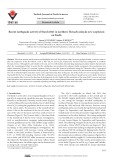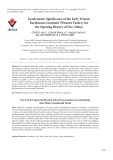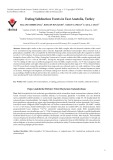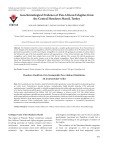
Geodynamic history
-
On October 30, 2020, a strong earthquake (Mw6.6–7.0) occurred offshore, just north of Samos Island, causing life losses, injuries and damages, especially on the Turkish side. The broader area is characterized by a complex geodynamic setting with both rich seismic history and numerous active faults of different direction and kinematics. The first aim of this study is to define the seismic source of the mainshock, based on seismological and geodetic data (GPS measurements and originally processed GNSS records), as well as our field observations on Samos Island few days after the mainshock.
 22p
22p  tanmocphong
tanmocphong
 29-01-2022
29-01-2022
 14
14
 0
0
 Download
Download
-
A geological interpretation of the faulting mechanism is also proposed. The existence of a new unknown source in an intermontane area is problematic. The role of inherited alpine structures seems more important today than in the past. The strike of the two new seismogenic sources, responsible for the two strongest events of the 2021 earthquake succession, differs from the previously known active faults. This forces us to reconsider older views on the direction of development of active faults and the orientation of the stress field.
 11p
11p  tanmocphong
tanmocphong
 29-01-2022
29-01-2022
 20
20
 0
0
 Download
Download
-
The Karaburun Peninsula, which is considered part of the Anatolide-Tauride Block of Turkey, contains clastic and carbonate sequences deposited on the northern margin of Gondwana. The Palaeozoic clastic sequence, which is intruded by the Early Triassic granitoid and tectonically overlies a Mesozoic mélange sequence, can be divided into three subunits: a lower clastic subunit consisting of a sandstone-shale alternation, an upper clastic subunit consisting of black chert-bearing shales, sandstone and conglomerate, and a Permo–Carboniferous carbonate subunit.
 17p
17p  vidonut2711
vidonut2711
 09-11-2019
09-11-2019
 14
14
 1
1
 Download
Download
-
Metamorphic studies in the cover sequences of the Bitlis complex allow the thermal evolution of the massif to be constrained using metamorphic index minerals. Regionally distributed metamorphic index minerals such as glaucophane, carpholite, relics of carpholite in chloritoid-bearing schists and pseudomorphs after aragonite in marbles record a LT–HP evolution.
 17p
17p  vidonut2711
vidonut2711
 09-11-2019
09-11-2019
 10
10
 1
1
 Download
Download
-
The Menderes Massif in western Anatolia documents a complex geodynamic history from Precambrian to recent. Eclogitic relics found in metagabbros in the Precambrian basement were dated by the U/Pb method. The zircon age data from granulitic (coronitic) and eclogitic metagabbros is consistent with geological constraints as well as relative and radiometric ages of the host granulitic gneisses and augen gneisses.
 17p
17p  vinasaki2711
vinasaki2711
 09-11-2019
09-11-2019
 11
11
 1
1
 Download
Download
CHỦ ĐỀ BẠN MUỐN TÌM


















